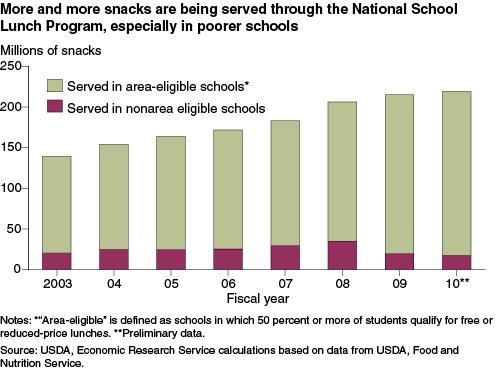Feeding Children After School: The Expanding Role of USDA Child Nutrition Programs
- by Joanne Guthrie
- 3/1/2012
USDA has a long history of subsidizing school meals through the National School Lunch Program (NSLP) and the School Breakfast Program. Increasingly, USDA is also involved in feeding children after school, especially low-income children. Participation in the after-school snack component of the NSLP is rising, and an after-school meal option for at-risk children, administered through USDA's Child and Adult Care Food Program (CACFP), was extended to all States in late 2010.
In fiscal year 2010, an average of 1.3 million after-school snacks were served daily through the NSLP, up from about 800,000 in 2003. Schools that participate in the NSLP can choose to offer nutritious snacks as part of after-school-care programs that provide educational or enrichment activities. Snacks must provide a serving from two of four food groups: milk, fruit and vegetables, grains, or meat and meat alternates, such as peanut butter. The program is highly targeted, with almost all snacks served in schools with high percentages of low-income students.
Snacks provided to students who qualify for free school meals receive a 76-cent subsidy for the 2011-12 school year. Schools providing snacks for reduced-price and full-price qualifying students are reimbursed at rates of 38 cents and 7 cents, respectively. Schools in which at least 50 percent of students qualify for free or reduced-price meals are 'area eligible' and receive the 76-cent subsidy for all participating students.
Funding for after-school snacks also comes from USDA's CACFP. Community centers that offer after-school enrichment programs can be reimbursed for snacks if they operate in low-income neighborhoods. Less than 35 million snacks were served under the 'at-risk' CACFP option annually in fiscal year 2010, compared with the more than 219 million snacks served through the NSLP.
The CACFP may become more involved with after-school nutrition through the expansion of an after-school meal option for at-risk children. Beginning in 2000, some State CACFP programs were allowed to offer after-school meals, typically suppers, through community programs in low-income areas. In December 2010, Congress extended this authority to all States. Suppers must include one serving each of milk, grains, and meat or meat alternates, and two servings of fruit and vegetables. At $2.77 per meal, however, the subsidy for after-school suppers is quite a bit higher than the subsidy for after-school snacks.
This article is drawn from:
- Child Nutrition Programs - After-School Snacks and Meals. (n.d.). U.S. Department of Agriculture, Economic Research Service.


